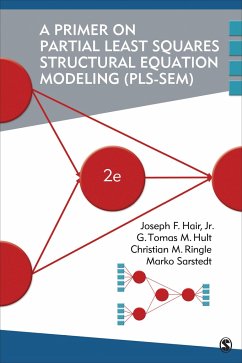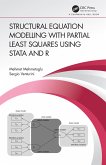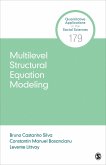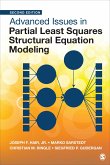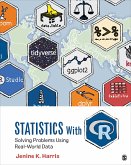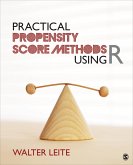Joe Hair, G. Tomas M. Hult, Christian M. Ringle
A Primer on Partial Least Squares Structural Equation Modeling (PLS-SEM)
Joe Hair, G. Tomas M. Hult, Christian M. Ringle
A Primer on Partial Least Squares Structural Equation Modeling (PLS-SEM)
- Broschiertes Buch
- Merkliste
- Auf die Merkliste
- Bewerten Bewerten
- Teilen
- Produkt teilen
- Produkterinnerung
- Produkterinnerung
Written with those with limited mathematical and statistical knowledge in mind, this concise and practical guide helps researchers to do their research in new and alternative ways.
Andere Kunden interessierten sich auch für
![Structural Equation Modelling with Partial Least Squares Using Stata and R Structural Equation Modelling with Partial Least Squares Using Stata and R]() Mehmet MehmetogluStructural Equation Modelling with Partial Least Squares Using Stata and R51,99 €
Mehmet MehmetogluStructural Equation Modelling with Partial Least Squares Using Stata and R51,99 €![Multilevel Structural Equation Modeling Multilevel Structural Equation Modeling]() Bruno Castanho SilvaMultilevel Structural Equation Modeling48,99 €
Bruno Castanho SilvaMultilevel Structural Equation Modeling48,99 €![Advanced Issues in Partial Least Squares Structural Equation Modeling Advanced Issues in Partial Least Squares Structural Equation Modeling]() Joe Hair (USA University of South Alabama)Advanced Issues in Partial Least Squares Structural Equation Modeling57,20 €
Joe Hair (USA University of South Alabama)Advanced Issues in Partial Least Squares Structural Equation Modeling57,20 €![Statistics with R Statistics with R]() Jenine K. HarrisStatistics with R217,99 €
Jenine K. HarrisStatistics with R217,99 €![Using Stata for Quantitative Analysis Using Stata for Quantitative Analysis]() Kyle C. LongestUsing Stata for Quantitative Analysis77,99 €
Kyle C. LongestUsing Stata for Quantitative Analysis77,99 €![Practical Propensity Score Methods Using R Practical Propensity Score Methods Using R]() Walter L. LeitePractical Propensity Score Methods Using R95,99 €
Walter L. LeitePractical Propensity Score Methods Using R95,99 €![Introducing Research Methodology Introducing Research Methodology]() Uwe FlickIntroducing Research Methodology123,99 €
Uwe FlickIntroducing Research Methodology123,99 €-
-
-
Written with those with limited mathematical and statistical knowledge in mind, this concise and practical guide helps researchers to do their research in new and alternative ways.
Produktdetails
- Produktdetails
- Verlag: SAGE Publications Inc
- Artikelnr. des Verlages: B77445P
- 2 Revised edition
- Seitenzahl: 384
- Erscheinungstermin: 5. April 2016
- Englisch
- Abmessung: 229mm x 154mm x 22mm
- Gewicht: 566g
- ISBN-13: 9781483377445
- ISBN-10: 148337744X
- Artikelnr.: 43774633
- Herstellerkennzeichnung
- Libri GmbH
- Europaallee 1
- 36244 Bad Hersfeld
- gpsr@libri.de
- Verlag: SAGE Publications Inc
- Artikelnr. des Verlages: B77445P
- 2 Revised edition
- Seitenzahl: 384
- Erscheinungstermin: 5. April 2016
- Englisch
- Abmessung: 229mm x 154mm x 22mm
- Gewicht: 566g
- ISBN-13: 9781483377445
- ISBN-10: 148337744X
- Artikelnr.: 43774633
- Herstellerkennzeichnung
- Libri GmbH
- Europaallee 1
- 36244 Bad Hersfeld
- gpsr@libri.de
Joseph F. Hair, Jr.is Professor of Marketing, PhD Director, and the Cleverdon Chair of Business in the Mitchell College of Business, University of South Alabama, USA. He previously held the Copeland Endowed Chair of Entrepreneurship and was Director, Entrepreneurship Institute, Ourso College of Business Administration, Louisiana State University. He has authored over 95 books, including Multivariate Data Analysis (8th edition, 2019) (cited 170,000+ times), MKTG (13th edition, 2019), Essentials of Business Research Methods, 5th edition, 2023), and Essentials of Marketing Research (6th edition, 2023). Dr. Hair is the most highly cited scholar in PLS-SEM and marketing, with 340,000+ citations (Google Scholar, 2023). He also has published numerous articles in scholarly journals and was recognized as the Academy of Marketing Science Marketing Educator of the year. A popular guest speaker, Professor Hair often presents seminars on research techniques, multivariate data analysis, and marketing issues for organizations in Europe, Australia, China, India, and South America.
Chapter 1: An Introduction to Structural Equation Modeling
What Is Structural Equation Modeling?
Considerations in Using Structural Equation Modeling
Structural Equation Modeling With Partial Least Squares Path Modeling
PLS-SEM, CB-SEM, and Regressions Based on Sum Scores
Organization of Remaining Chapters
Chapter 2: Specifying the Path Model and Examining Data
Stage 1: Specifying the Structural Model
Stage 2: Specifying the Measurement Models
Stage 3: Data Collection and Examination
Case Study Illustration: Specifying the PLS-SEM Model
Path Model Creation Using the SmartPLS Software
Chapter 3: Path Model Estimation
Stage 4: Model Estimation and the PLS-SEM Algorithm
Case Study Illustration: PLS Path Model Estimation (Stage 4)
Chapter 4: Assessing PLS-SEM Results Part I: Evaluation of Reflective
Measurement Models
Overview of Stage 5: Evaluation of Measurement Models
Stage 5a: Assessing Results of Reflective Measurement Models
Case Study Illustration-Reflective Measurement Models
Running the PLS-SEM Algorithm
Reflective Measurement Model Evaluation
Chapter 5: Assessing PLS-SEM Results Part II: Evaluation of the Formative
Measurement Models
Stage 5b: Assessing Results of Formative Measurement Models
Bootstrapping Procedure
Bootstrap Confidence Intervals
Case Study Illustration-Evaluation of Formative Measurement Models
Chapter 6: Assessing PLS-SEM Results Part III: Evaluation of the Structural
Model
Stage 6: Assessing PLS-SEM Structural Model Results
Case Study Illustration-How Are PLS-SEM Structural Model Results Reported?
Chapter 7: Mediator and Moderator Analysis
Mediation
Moderation
Chapter 8: Outlook on Advanced Methods
Importance-Performance Map Analysis
Hierarchical Component Models
Confirmatory Tetrad Analysis
Dealing With Observed and Unobserved Heterogeneity
Consistent Partial Least Squares
What Is Structural Equation Modeling?
Considerations in Using Structural Equation Modeling
Structural Equation Modeling With Partial Least Squares Path Modeling
PLS-SEM, CB-SEM, and Regressions Based on Sum Scores
Organization of Remaining Chapters
Chapter 2: Specifying the Path Model and Examining Data
Stage 1: Specifying the Structural Model
Stage 2: Specifying the Measurement Models
Stage 3: Data Collection and Examination
Case Study Illustration: Specifying the PLS-SEM Model
Path Model Creation Using the SmartPLS Software
Chapter 3: Path Model Estimation
Stage 4: Model Estimation and the PLS-SEM Algorithm
Case Study Illustration: PLS Path Model Estimation (Stage 4)
Chapter 4: Assessing PLS-SEM Results Part I: Evaluation of Reflective
Measurement Models
Overview of Stage 5: Evaluation of Measurement Models
Stage 5a: Assessing Results of Reflective Measurement Models
Case Study Illustration-Reflective Measurement Models
Running the PLS-SEM Algorithm
Reflective Measurement Model Evaluation
Chapter 5: Assessing PLS-SEM Results Part II: Evaluation of the Formative
Measurement Models
Stage 5b: Assessing Results of Formative Measurement Models
Bootstrapping Procedure
Bootstrap Confidence Intervals
Case Study Illustration-Evaluation of Formative Measurement Models
Chapter 6: Assessing PLS-SEM Results Part III: Evaluation of the Structural
Model
Stage 6: Assessing PLS-SEM Structural Model Results
Case Study Illustration-How Are PLS-SEM Structural Model Results Reported?
Chapter 7: Mediator and Moderator Analysis
Mediation
Moderation
Chapter 8: Outlook on Advanced Methods
Importance-Performance Map Analysis
Hierarchical Component Models
Confirmatory Tetrad Analysis
Dealing With Observed and Unobserved Heterogeneity
Consistent Partial Least Squares
Chapter 1: An Introduction to Structural Equation Modeling
What Is Structural Equation Modeling?
Considerations in Using Structural Equation Modeling
Structural Equation Modeling With Partial Least Squares Path Modeling
PLS-SEM, CB-SEM, and Regressions Based on Sum Scores
Organization of Remaining Chapters
Chapter 2: Specifying the Path Model and Examining Data
Stage 1: Specifying the Structural Model
Stage 2: Specifying the Measurement Models
Stage 3: Data Collection and Examination
Case Study Illustration: Specifying the PLS-SEM Model
Path Model Creation Using the SmartPLS Software
Chapter 3: Path Model Estimation
Stage 4: Model Estimation and the PLS-SEM Algorithm
Case Study Illustration: PLS Path Model Estimation (Stage 4)
Chapter 4: Assessing PLS-SEM Results Part I: Evaluation of Reflective
Measurement Models
Overview of Stage 5: Evaluation of Measurement Models
Stage 5a: Assessing Results of Reflective Measurement Models
Case Study Illustration-Reflective Measurement Models
Running the PLS-SEM Algorithm
Reflective Measurement Model Evaluation
Chapter 5: Assessing PLS-SEM Results Part II: Evaluation of the Formative
Measurement Models
Stage 5b: Assessing Results of Formative Measurement Models
Bootstrapping Procedure
Bootstrap Confidence Intervals
Case Study Illustration-Evaluation of Formative Measurement Models
Chapter 6: Assessing PLS-SEM Results Part III: Evaluation of the Structural
Model
Stage 6: Assessing PLS-SEM Structural Model Results
Case Study Illustration-How Are PLS-SEM Structural Model Results Reported?
Chapter 7: Mediator and Moderator Analysis
Mediation
Moderation
Chapter 8: Outlook on Advanced Methods
Importance-Performance Map Analysis
Hierarchical Component Models
Confirmatory Tetrad Analysis
Dealing With Observed and Unobserved Heterogeneity
Consistent Partial Least Squares
What Is Structural Equation Modeling?
Considerations in Using Structural Equation Modeling
Structural Equation Modeling With Partial Least Squares Path Modeling
PLS-SEM, CB-SEM, and Regressions Based on Sum Scores
Organization of Remaining Chapters
Chapter 2: Specifying the Path Model and Examining Data
Stage 1: Specifying the Structural Model
Stage 2: Specifying the Measurement Models
Stage 3: Data Collection and Examination
Case Study Illustration: Specifying the PLS-SEM Model
Path Model Creation Using the SmartPLS Software
Chapter 3: Path Model Estimation
Stage 4: Model Estimation and the PLS-SEM Algorithm
Case Study Illustration: PLS Path Model Estimation (Stage 4)
Chapter 4: Assessing PLS-SEM Results Part I: Evaluation of Reflective
Measurement Models
Overview of Stage 5: Evaluation of Measurement Models
Stage 5a: Assessing Results of Reflective Measurement Models
Case Study Illustration-Reflective Measurement Models
Running the PLS-SEM Algorithm
Reflective Measurement Model Evaluation
Chapter 5: Assessing PLS-SEM Results Part II: Evaluation of the Formative
Measurement Models
Stage 5b: Assessing Results of Formative Measurement Models
Bootstrapping Procedure
Bootstrap Confidence Intervals
Case Study Illustration-Evaluation of Formative Measurement Models
Chapter 6: Assessing PLS-SEM Results Part III: Evaluation of the Structural
Model
Stage 6: Assessing PLS-SEM Structural Model Results
Case Study Illustration-How Are PLS-SEM Structural Model Results Reported?
Chapter 7: Mediator and Moderator Analysis
Mediation
Moderation
Chapter 8: Outlook on Advanced Methods
Importance-Performance Map Analysis
Hierarchical Component Models
Confirmatory Tetrad Analysis
Dealing With Observed and Unobserved Heterogeneity
Consistent Partial Least Squares

